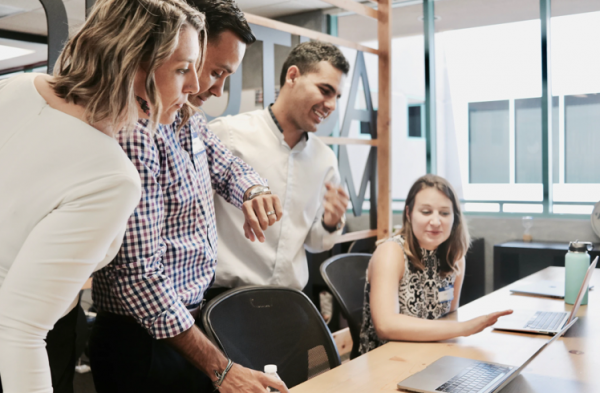
The success of any 21st century business can be distilled down to three key factors: people, place, and technology. However, while many companies put a great deal of effort into hiring the best people and then equipping them with the latest tech, the environment in which they work usually receives less attention.
Changing the design of a workplace with agile in mind will bring home the amazing benefits that come from paying attention to ‘place’. Here is why.
- Easier and better communication
Communication is the difference between a group of individuals and a real team. Transparency and communication are often linked terms and we found that our communication benefited when we took ‘transparency’ literally.
Getting rid of cubicles and walls, opening up the space, using glass paneling, getting managers out of those corner offices, and transmitting important data via easy-to-see display screens… all made our environment more transparent and we found that when people can simply look up and see their colleagues they are much, much more likely to communicate with them.
- Enhanced collaboration
Collaboration is key. The good news is in the 21st century we are much more inclined to collaborate. Social media is a significant enabler, encouraging wide-ranging communities by providing a flexible space beyond traditional boundaries of country and culture. The same thing happens in your office when you create new opportunities for people to meet and exchange knowledge outside of the interactions that their specific roles demand. We created a ‘work anywhere’, plug-n-play office with standardized workstations and disrupted the ergonomics by reducing the number of natural meetings points (water coolers, coffee machines, printers) and creating less predictable spontaneous gatherings. Having a dedicated café space also boosted our level of unplanned conversations and problem-solving.
- Counter-intuitive efficiency
The right design boosts overall company efficiency but often not in the ways you might imagine. You might think locating the bathrooms so that people have to walk through the main office space past the café and kitchen to reach them is inefficient. But the chance meetings on that short walk more than repaid the slightly longer journey.
We were inspired by the example of the Norwegian telecom company Telenor. They ditched hundreds of coffee machines, forcing staff to go to the cafeteria for a cup of joe. The result? More communication and collaboration and a better information flow, all leading to a 20% increase in profits!
- Fun!
Research shows that creating a fun environment for people improves mood, boost problem-solving, and increases the quality of the work done. We upped the fun factor by creating a variety of spaces, including chaos rooms for noisy play, silence rooms for contemplation, outdoor spaces for a literal breath of fresh air, and the café as our social hub. Each offers a different working experience to match individual moods and as a result encourages a more relaxed (and productive) frame of mind.
A team’s success is greatly influenced by where it works and having an agile office that is designed to make working together a pleasurable experience actually pushes that team to work in a more agile way, achieving better quality results more efficiently.
